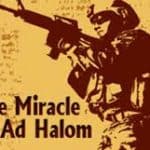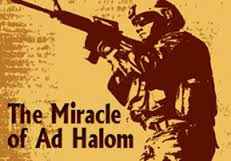 quiet English-speaking pilot that loved classical music, was the IAF’s first martyr. The people of Ashdod and all of Israel owe him a debt of eternal gratitude.
quiet English-speaking pilot that loved classical music, was the IAF’s first martyr. The people of Ashdod and all of Israel owe him a debt of eternal gratitude.
Israel’s Memorial Day, Yom HaZikaron, begins this year on Tuesday evening, April 24, 2012. Israel never forgets its debt of eternal gratitude to its sons and daughters who gave their lives for the achievement of the country’s independence and its continued existence. It is a day of collective and personal heartache mingled with awe and honor for our holy martyrs.
When looking at Israeli military history, most people consider the Six-Day War of 1967 as Hashem’s greatest miracle of modern times. My choice would be the War of Independence of 1948-49.
In the initial stage of the War of Independence, the Egyptian, Syrian, Iraqi and Jordanian armies scored notable successes. It looked like the tiny Jewish nation would be finished before it began its modern-day rebirth. The formidable Egyptian army – backed by tanks, artillery, armor and aircraft, which Israel did not have – were able to cut off the entire Negev and to occupy parts of the land that had been allocated to the Jewish state, reaching as far north as Ashdod.
The Jordanian Legion succeeded in defending their key position in Latrun after a bloody aborted attempt by an untrained and inexperienced Israeli assault force that included quite a few Holocaust survivors that had recently arrived in Israel from the deportation camps of Europe. They also overran and captured Gush Etzion.
The Iraqis had almost reached the Mediterranean and the Syrians were dangerously near Haifa. Jerusalem, with 100,000 Jews was virtually cut off from the rest of Israel. Hacked to pieces in this way, Israel was not very far from collapse in June of 1948.
The Israeli Army then was not much more than new immigrants from Europe and Morocco with a few kibbutznik commanders. Many of the soldiers had no firearms. Some had never shot a rifle and had little idea of what to do in a battle. If a “rare” machine gun broke down or needed assembly, it was necessary to wait for a rare expert to come along who knew how to assemble and repair machine guns.
Most of the Israel’s soldiers had had little or no training. Thousands of them were new immigrants rushed off the boats and given guns, most unable to speak Hebrew and understand commands.
The Egyptian Army dealt a nasty blow to the Givati brigade in the Battle of Nitzanim, a mile south of Ashdod. It looked like nothing could stop the Egyptians from reaching Tel Aviv; then, the war would be over and so would the State of Israel, Heaven forbid.
The morale of the Egyptians was high and the Egyptian press and people were already celebrating. First, they seized Gaza, then Majdal (Ashkelon), then Beersheba and now Nitzanim with Ashdod next on the list. By Egyptian calculations, Israel’s ill-equipped armies and settlements would fall swiftly. Egypt also hoped to reach the Ramle area to link up with the Arab Legion’s forces at Latrun. Such a move would be a mortal blow to the Jewish forces.
Yet Hashem had other plans. An Egyptian column of some 500 vehicles was making its way up the Coastal Road towards Tel Aviv. The column was confronted by a bold company of Givati soldiers who had miraculously exploded the sturdy Turkish bridge over the Lachish river at the Southern entrance of Ashdod to delay the Egyptian advance. Barely 20 miles separated the enemy from its objective.
With no time to waste before the Egyptians could circumvent the bombed out “Ad Halom” (“up to here” in Hebrew, the northernmost point of the Egyptian thrust into Israel) bridge, Israel tried its first aerial attack. Lou Lenart, an experienced American volunteer, was selected to lead the historic mission. He was joined by Moddy Alon, Ezer Weizman, and Eddie Cohen.
Each plane swooped down on the enemy with two 70-kg bombs. They tried to strafe the Egyptian column despite heavy ground fire. Unfortunately, the Messerschmitts’ untested 20 mm cannons and machine guns jammed quickly and the few rounds that they fired didn’t inflict much damage. But the psychological effect was enormous. The surprised Egyptians thought they were being hit by a massive air bombardment. They panicked and scattered all over the adjacent sand dunes. By the time they regrouped, they had lost the offensive.
Israel’s outnumbered Givati forces seized the opportunity to launch a counterattack. With Hashem’s loving grace, they stopped the advance in its tracks.
The price of success was high: Eddie Cohen, a South African-born pilot, was killed when his Messerschmitt – apparently hit by anti-aircraft fire – crashed and burned trying to land after the mission. As a result, the First Jewish Fighter Squadron lost one-fourth of its aircraft and one-fifth of its pilots on its maiden combat sortie.
Eddie Cohen of blessed memory was not the macho type of pilot. Indeed, he was contemplative, calm, scholarly, never daring, and never reckless or adventurous. This anti-hero was the Israeli Air Forces’s first heroic martyr. He merited being Hashem’s emissary in the formidable miracle that turned the tide of Israel’s War of Independence.
With an army that wasn’t an army, an air force that wasn’t an air force, and a pilot that preferred classical music and archeology to flying warplanes that weren’t much more than souped-up Piper Cubs, Hashem chose to perform the miracle of Ad-Halom on the outskirts of my beloved hometown of Ashdod.
“They have their chariots and they have their horses, but we shall call the Name of Hashem our G-d!” (Psalm 20:8)
Rabbi Lazer BrodyRabbi Lazer Brody was born in Washington, D.C. in 1949. After receiving his bachelor’s degree in agriculture from the University of Maryland in 1970, he moved to Israel and joined the Israel Defense Forces regular army, and served in one of the elite special-forces units. He is a decorated combat veteran of two wars and numerous of counter-insurgence and anti-terrorist missions on both sides of Israel’s borders.
Rabbi Brody is the English-language editor of Breslev Israel’s highly popular English-language website at www.breslev.co.il, and the founder and director of Emuna Outreach. Between Breslov Israel and Emuna Outreach, he devotes his time to spreading emuna and particularly the teachings of Rebbe Nachman of Breslev around the globe.
“Lazer Beams,” Rabbi Brody’s award-winning daily web journal, has been instrumental in helping tens of thousands of people around the globe find joy and fulfillment in their lives.
